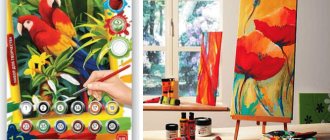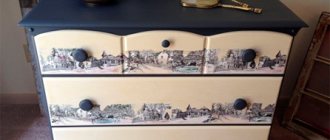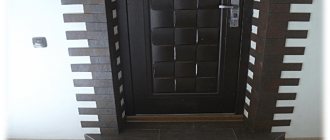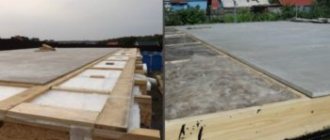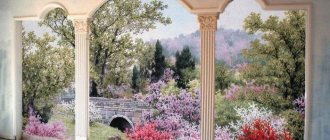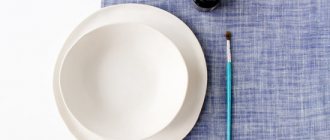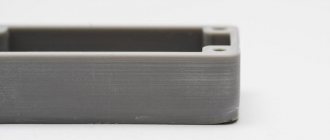Features of oil bases
Compared to watercolor, gouache or acrylic, oil base is more fluid. Thorough mixing is necessary to create a uniform color. At the same time, this feature of the paints allows you to obtain additional artistic effects:
- When fully mixed, an even color is obtained, suitable for both drawing and painting surfaces.
- With partial mixing, darker or lighter tinting particles will be visible in the base, which, when drawn, look like veins, giving the picture originality and unusualness.
Taking into account this feature of the dye, using partial mixing, you can create an original room decor.
A little about mixing
The main color palette, although extensive, does not have many additional shades. To obtain the desired color tone, you need to mix two or more basic shades. How to mix oil paints to get the desired result? To do this, you need to use a table that shows the color palette of the required colors, and how to obtain them by combining the desired tones. Such tables are used not only by beginners, but also by experienced designers. The tables are made very conveniently, they indicate:
Mixing colors to obtain the desired shade
- The name of the color to be obtained and what color range is needed for tinting. For example, you need a golden shade. We look for this name in the table, and next to the desired color scheme the color scheme required for mixing will be indicated. In the case of gold, to obtain it you need to add a drop of brown or red to the yellow.
- A combination of shine. For example, you want to know what kind of shine is obtained when combining matte and glossy paints of different colors. As a rule, if you add a drop of glossy paint to matte, its calm matte shine will not be disturbed, but if you do the opposite, then the glossy color will slightly dull the matte shine. A mixture of matte and glossy shine is often used by interior designers to emphasize the transition of halftones.
Once you figure out how to use the tables, you can try to make your own color palette and use it to create a design or artistic masterpiece.
Acrylic paints
These materials are universal, they are used for many purposes: with their help you can simply paint walls, paint stained glass windows, apply designs on the wall and ceiling. In general, the scope of their use is limited by imagination. The compositions are easy to use and adhere well to the surface. But if you decide to paint a multi-component image on the wall, then buying paint in all the necessary colors will be too expensive, and after completion of the work there will be a large amount of unnecessary material left. In this case, it is better to buy a basic series, and to create certain shades, mix acrylic paints.
Mixing base paint colors makes it possible to get many different shades, while you can save a lot on your purchase
Main color range
Everyone knows from school: when you combine yellow and red, you get orange, but if you add blue to the same yellow, you get green. It is on this principle that the table for mixing acrylic paints is built. According to it, it is enough to purchase only the primary colors:
- white;
- black;
- red;
- brown;
- blue;
- yellow;
- pink.
You can simply mix acrylic paints of these tones to get most of the existing shades.
Basics of mixing according to the table
To properly mix materials, you cannot do without a table. At first glance, it is easy to work with: to get the desired result, you just need to find the color and see what components are required. But the color mixing table does not indicate the proportions, so it is necessary to gradually add tinting material to the base paint and apply the mixture to some unnecessary product: a sheet of plywood, drywall, and so on. Then you need to wait until the material dries. If the color matches what is required, you can begin work on the main surface.
Color Mixing Chart:
Coloring technique
Now about how to get colors. By mixing acrylic materials, you can achieve the formation of two main tones: light and dark. Basic tones: earthy, green, orange, purple. To create color, it is recommended to follow certain rules:
- Light. In this case, the main material is titanium white, to which one or two tinting compounds are added. The less additional paintwork materials are used, the lighter the tone will be. This is how you can make most shades of a light palette.
- Dark. To create shades of this type, do the opposite. Before mixing colors, you need to prepare the base tone; black dye is gradually introduced into the base. When working with black paint, you need to be careful because it can make the color look muddy rather than dark.
- Green. This shade is not in the main palette, so you will need to mix yellow and blue. The exact ratio can only be determined experimentally.
- Violet. This is a cool color that is obtained by mixing blue with pink or red. In some cases, you will also need to add black to darken the material.
- Orange. To create this color you need to mix red and yellow. For a richer orange, it is recommended to add more red and vice versa. If you want to create a soft color, for example, coral, then you need to lighten the material with white. Can I add dark dyes? Yes, you can, but mixing colors may result in a muddy tone.
- Earthy. Here the main color is brown. By adding various shades to it, they get a color from beige to dark wood.
Rules for working with the palette
To begin, you will need a basic set of paints, brushes, a container of water and a palette (you can take any surface, including school supplies for drawing).
We recommend: MA-15 paint – description, technical characteristics and varieties
It is recommended to place white in the center, since it is used in creating most shades. Dyes of the main color range are placed in the recesses around (if any). You need to mix carefully, gradually adding tinting material and constantly checking the result. After mixing the colors, the brush should be rinsed in a container of water.
On a note! Working with materials based on acrylic resins using a table and palette is quite simple. The main thing is to practice more, the result will get better each time.
How to mix correctly
If the desired color scheme will not be used to create an artistic painting, tinting can be done in two ways:
- by adding a color tint to the oil base (this tint is sold in all hardware stores and is suitable for dyes on any base);
- mixing oil bases in various ways.
Primary colors in mechanical mixing
In painting, mixing occurs using the following techniques.
Mechanical mixing
The result is achieved by mixing two or more bases of different colors. The main thing with this technique is thorough mixing to achieve complete homogeneity of the dye.
But you should not rely only on the table data (a slight deviation of the original tone from the indicated one can give a completely different result); it is better to try to develop your own color perception, which allows you to determine the ratio “by eye”, by trial and error. Just try the resulting mixing result not on the main picture, but on any unnecessary surface.
Color overlay
This method requires some skill and developed color perception. Before starting decorating, it is advisable for novice craftsmen to practice on unnecessary surfaces. The method is that a new tone is applied on top of a slightly dried smear, and a partial mixing of the color structures on the base occurs.
Optical illusion
This method is only suitable for masters, when the illusion of a completely different tone is created through skillfully selected color combinations and differences in the gloss of dyes.
Peculiarities
All three techniques, when using the same color palette, allow you to obtain different shades. The mechanical mixing palette matches the data in the table. The color scheme obtained by overlay and partial mixing can give interesting tones, the names of which only professional artists know. But for successful decoration it is not necessary to know the names; it is enough to create a beautiful and unusual effect.
With spatial mixing, the result does not necessarily depend on the color. You can get a dark green tint if you apply any glossy tone next to matte green. Beginners will not be able to achieve such optical games in drawing right away, but if you have the desire, then with a little practice you can get amazing results using the color palette and gloss differences.
Also, to create optical effects, the glaze method is used, when a translucent glaze layer is applied over the dense structure of the dye after drying and one shade shines through the other.
What colors make beige
Beige is a light brown color with a cream or yellow tint. It is not an independent tone. Craftsmen get it by mixing several colors of gouache, acrylic or another type of paint, so the beige color can be warm or cold. When mixing white (60%!) and golden ocher (30%!) with the addition of a few drops of red or brown to soften and a small amount of green dye, the tone will be quite cool.
We recommend: Features and properties of aerosol paint
Warmer shades are obtained by combining brown, white and yellow components or yellow, blue, red and white.
The simplest, classic way to get a beige shade is to combine white with brown. The resulting color depends on the proportions of the diluted ingredients. The more dark, the more saturated the color; the more white, the lighter and softer it is.
How to apply ready-made dye
If you want to seriously engage in design work or start painting, you can master all the mixing techniques. But for household decoration, complete and incomplete mixing is sufficient. Work with oil as follows:
- Prepare the color on the palette immediately before use.
- Apply strokes using a brush or a special swab (it is difficult to correct mistakes when painting with oil).
- Apply the next layer only after the previous one has dried (exception is the partial mixing method).
- If the color changes, clean the brush with a solvent.
By following these simple rules and taking into account the peculiarities of the oil structure when mixing, even a beginner will be able to create a beautiful room decor or draw a planned pattern on the wall.
